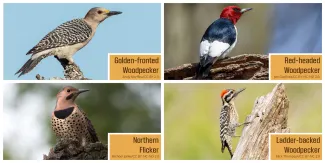For many Oklahoma birders, woodpeckers are a somewhat expected staple. As a group, the insect eating, drumming machines can be spotted across the state at any time of the year, in almost every habitat. But some of the state’s 14 documented species are more challenging to find than others.
During a survey near the community of Vinson, Mark Howery, a senior biologist with the Wildlife Department, hauled in a remarkable collection of woodpeckers, including two species with limited ranges in the state. Vinson, located eight miles east of the Texas state line in Harmon County, resembles much of southwestern Oklahoma’s mesquite grasslands.
“It really surprised me,” Howery said. “I saw golden-fronted woodpeckers, red-headed woodpeckers, northern flickers, and ladder-backed woodpeckers. And I was able to get confirmation of nesting for each species.”

Four Remarkable Woodpecker Sightings
In early July, Howery returned to the Vinson Breeding Bird Atlas survey block to monitor the area’s breeding birds for the third and final time of the season. That day, he saw 38 species and had confirmation of breeding activity for 12 species, including four species of woodpecker.
“I saw a pair of golden-fronted woodpeckers carrying food in their bills as they flew through a wooded draw,” Howery said. The bird closely resembles the more common red-bellied woodpecker, but is rarely spotted in the state outside of the southwestern region. Howery only observed the birds on his third trip to the atlas block.
“Then I saw a pair of red-headed woodpeckers doing the same thing. They were right by the road, and I could see them carrying food to a hole in a dead cottonwood.” Of the four woodpecker species documented in this atlas block, the red-headed woodpecker was the most consistent. “I saw four to five birds on each of the three trips.
“Then I saw a family group of northern flickers – there was an adult pair and three fledglings with dark mustaches. One of the weird things about flickers is that juveniles have male plumage as their first plumage. I don’t know of another bird that does this – most juveniles look like the females in their first year.” The flickers, the most common and widespread of the four woodpeckers spotted during the survey, were seen on Howery’s first and third surveys, in the same area of the atlas block.
“About two-and-a-half hours later, I was circling back through a small grove of mesquite trees at the end of the route and saw a family group of ladder-backed woodpeckers. There were two adults and two fledglings on both sides of the road.” Ladder-backed woodpeckers are small in size and prefer arid habitats.
All told, Howery spotted 47 bird species in the Vinson survey block during the 2023 breeding season and confirmed the nesting status of 22 species.
Confirming nesting or breeding birds was the goal of Howery’s survey as part of the second Oklahoma Breeding Bird Atlas effort. The project, coordinated by the Sutton Avian Research Center, with funding support from the Wildlife Department’s State Wildlife Grants Program, is documenting evidence of nesting birds – either of adult birds carrying nesting material or food to a nest, or of fledgling or juvenile birds – in 583 3-mile-square blocks across the state.
During the first Oklahoma Breeding Bird Atlas, conducted from 1997 to 2001, project personnel and volunteer birders visited 573 of the 583 designated blocks, spending an average of 13 hours surveying within each block, and documented 212 species. At least 160 species were confirmed to breed within the state, and an additional 38 species were marked as possible or probable breeders because of observations of singing males.
The ongoing atlas project will serve as a 20-year follow-up to the first survey effort and can be used to compare bird distributions in the state and document any changes during the intervening years. For the Vinson block, Howery documented an additional 14 species when compared to the first Oklahoma Breeding Bird Atlas project and confirmed nesting behavior of 10 more species than the previous effort.
Surveys for the second atlas began in 2020 and are planned to conclude in 2024.
The second Oklahoma Breeding Bird Atlas is supported by State Wildlife Grant F21AF03463. Howery’s survey was funded by State Wildlife Grant F22AF02644.